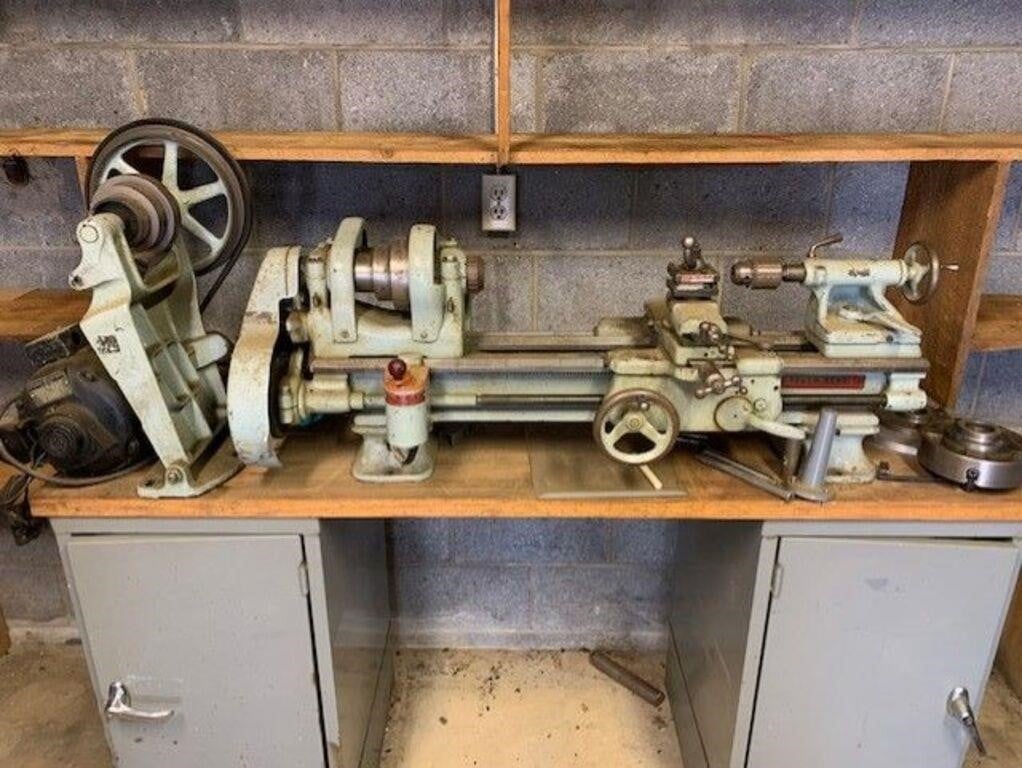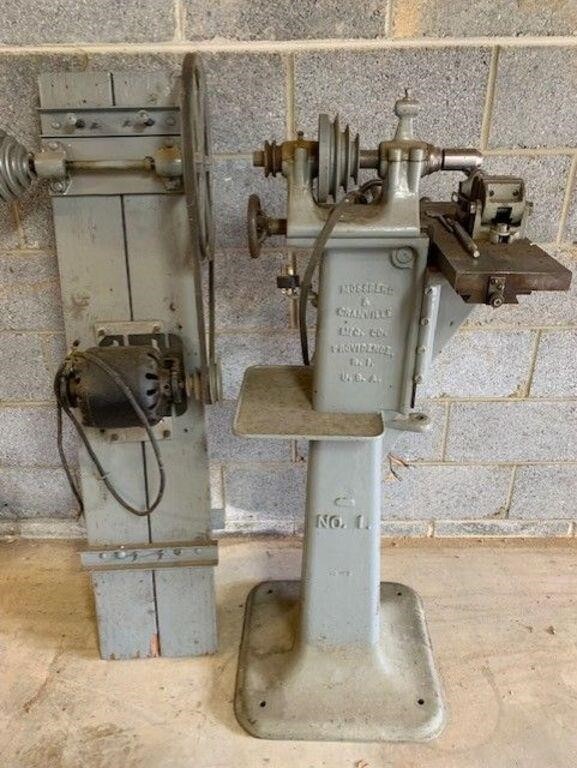There's an estate auction near me that will be starting up in a few days. Among the lots are an old South Bend lathe and a Mossberg and Granville side mill. both appear quite old and used.


Are these worth anything, and would they be of use to the modern automotive tinkerer? I'm not much into fabrication yet, so my knowledge of such machines is very small. I think they're cool though, and I'm sure I could find a use for them if I wanted to :)
I suspect its modern equivalent would cost a small fortune. Being old, it was likely designed to last forever. The key is whether you'd need to pay someone to put it in working order or if you can accomplish that task yourself.
The mill looks like it would probably have only limited useability, but the lathe could be a good tool. With any sort of machine tool the expensive part could be tooling - does it come with any? Also, it should be checked to make sure it's not worn out to the point where it's not accurate enough to be useful. The bed can be reground flat but that's not a cheap endeavor.
The lathe comes with a bunch of extras - the ad says about 25 pcs. Some more pics:





Mr_Asa
UltimaDork
11/17/22 3:33 p.m.
Horizontal mills have fallen out of favor in recent years. You could probably get that for fairly cheap.
Lathes are also kinda cheap, depending on condition. $500 for the pair, maybe?
FWIW - I know where a lathe that predates electrical power in NYC is. Used to run on belts from a steam system, been upgraded to a 3-phase motor. Still choochin today, so age isn't necessarily a factor.
In reply to AMiataCalledSteve :
I used a similar lathe and a really big verticals mill originally driven by belts from a water wheel to build all sorts of brackets and fixtures etc. age really doesn't matter. You'll figure out how to achieve what you want even if it's not obvious. In spite of wear.
You can get really creative and can achieve beautiful work just by messing around until you are comfortable. I never did have any lessons.
The Jaguar factory had a lot of pre war ( WW2 ) machinery and the workers should haul out a big old file and make a pass or two to deal with that wear. Watching them in the 1980's movie they were still using that file!
my lathe looks almost exactly like that, but i think my bed is longer. i also have that book from South Bend. I see these lathes listed anywhere from $500 to $1500 on FBMarketplace
The Jaguar factory had a lot of pre war ( WW2 ) machinery and the workers should haul out a big old file and make a pass or two to deal with that wear. Watching them in the 1980's movie they were still using that file!
Do you have a link to the Jaguar movie ?
Assuming it's in good condition that lathe could be quite useful. I didn't see any change gears in the pictures and if they're missing that will reduce its usefulness a bit.
The mill is probably just a novelty. You could do some stuff with it but it's unlikely that it takes any common tooling and it looks pretty light duty.
Pricing is going to depend on location, tooling and condition. Hear in the Southwest used machine tools are hard to come by and that lathe could bring between $1,500 and $2,000. In Connecticut where used machine tools are plentiful that's probably about $1,000 less than that.
I learned how to run a lathe on a South Bend brand machine. It was a bigger version but most lathes work the same.
I would do a search on SB lathes to see what if any parts are still available for the machine.
While I learned on a SB lathe I bought a Logan lathe for my home shop.
I'm near Chicago and Logan was a Chicago based company when it was in business.
There is a small company NW of Chicago that still sell parts and service for these lathes.
If they don't have a part they will make it if possible.
I agree on the $500 valuation, but as mentioned... Those are fairly common near me. Is the northeast the ATL of machine tools? It'd be worth more if it has the integral gearbox, but change gears are readily available on ebay at least.
Anyways, if you look at it in person, bring a nice straight edge and some feeler gauges to see if the bed is worn near the headstock. Luckily lathe tooling is considerably less expensive than mill tooling, for what it's worth.
I wouldn't mess with that mill unless you have plenty of floorspace or want it as an art piece. I bet it sells for cheap.

NOHOME
MegaDork
11/17/22 7:42 p.m.
In actual value, not much more than scrap weight.
But in an auction, it all depends on who is bidding and what their motivation might be. "Collectors" and "Sentimentalist" are not worth bidding against since you want it, but they "Need" it.
The tooling to be had is a big determinant since it is very expensive to buy.
This is the kind of thing you bid $500 or so and almost kind of hope you dont end up having to pick up.
Yeah I agree with previous posters. That mill is decoration at this point.
the lathe could be used, it would be slow with no DRO's or quick change tooling. I wouldn't give more than a few hundo for it. Not that it isn't cool or well built. They do just come along though and if you keep an eye out one will show up on marketplace or CL with a gang of tooling. Unfortunately it is a declining population of interested people in them. Typically that amazing deal is directly after you buy one that isn't a great deal. That happened with my mill!
The lathe looks to be a South Bend 9c. If it has all the change gears it's worth $400 to $1500 depending on condition and tooling.
I paid $400 for my 9A tool room lathe 25 years ago. They are surprisingly capable machines.

The mill probably isn't worth much unless you are a collector.
If you want it don’t bid $500 even. Bid up to $507.69 or something like that.
I bought my home in a sealed bid auction. I was told I won the bid by $166.89 or so I was told. Paranoia for the win!

Honsch
Reader
11/18/22 1:33 a.m.
The problem with old lathes like that are twofold.
1. The plain bearings holding the spindle are usually shot and chatter and accuracy are a real issue.
2. The ways/saddle are warn a lot more near the spindle than the tailstock so you have accuracy issues.
Also, if there are no change gears with the lathe then you can't cut screws, and there's no thread dial so that's another strike against. The picture of the restored lather has the quick-change gear set which the lathe in question does not.
If all you wanted to do was make the occasional round thing have a smaller outer diameter or larger inner diameter you could make it work. That's about all that machine is capable of without some financial investment and a lot of work.
If you haven't already, check out my article on lathe buying:
https://grassrootsmotorsports.com/articles/buying-lathe-making-stuff-part-4/
If you can grab it for a few hundred bucks I would. Otherwise don't bother.
The mill isn't worth dragging home.
In reply to Honsch :
You can do a lot more than that. But yes the main thing I did with my lathe was make bushings.
I'd drill it out slightly under size and ream it to the correct size. Cut the out diameter to slightly over the desired size and use a file to bring it down to proper size.
Just having one on hand any time you're going to need it is well worth the slight cost. You're not stopping your project and going and finding a machinist who has time to get to it sometime next week or month. Explaining what you want done and your tolerance allowance. Maybe even coming up with a blueprint.
It's not rocket science to take a lathe apart and push out the old bearings either.
Once you start doing a little machine work you'll find ways to do more. Before I got my vertical mill I used to relieve pistons using a fly cutter in a drill press where the piston was clamped in a wooden holding block. I used to balance rods and pistons using a home made balance beam.
The lathe is 1.5 to 2x scrap metal value. No way to verify how worn it is and getting a pro to look at it would be a few hundred just to tell you what it will need. Accuracy of this lathe could be pretty bad, OK for turning suspension bushings or low tolerance stuff. Getting used to the old tech and compensating for lead screw slop will take some time. Typing about time, this is probably your first look into the old machinery business so there is still lots to learn. I have seen some real crap out there and watched people spend too much money thinking they could make it work.

I'm going to have to agree with frenchyd on this.
I have built everything from backhoe pins and bushing to driveshafts on my 9. All of these driveshaft parts were made on my 1947 SB9.


The welding was done on my 1950s SB16.



The spindle bushings on a SB9 are easily shimmed to tolerance. As long as the spindle turns smoothly without excessive play I wouldn't worry about it. The bed may well be worn. My SB16 has about .004" of sway in the bed at the chuck. Turning short pieces you will never notice it. Turning long pieces, you can compensate for it if needed but usually, the taper is well within my tolerance. I'm not a production shop making cranks, I'm making short shafts and bushings or modifying parts for my needs.
As to threads, I've never needed to cut them on a lathe. I have taps and dies through 1". They are easier to set up and have less chance of screwing a part up. I may need to one day but not yet.
If this machine is available for a couple of hundred, it's worth it. An old lathe is infinitely better than no lathe, though it may be worthwhile to hold off and see if you can find a SB9A. The 9A machine will have a powered cross slide as well as the quick change gearbox, both of which are very nice to have.
Is the voltage what you have in your garage ?
Thanks for the info, everyone! Here's the ad if anyone wants to see the rest of the pictures https://lightintheatticestates.hibid.com/lot/138637635/south-bend-industrial-lathe?cpage=5
In reply to Tom Suddard :
Thanks for the article link, I'm not sure how I misse that but it was a very educational read























































